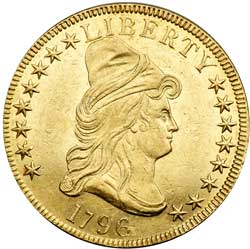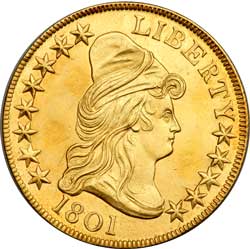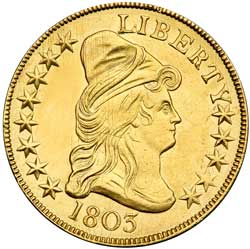
|
Sale 78
January Pre-Long Beach Sale 17.5% BP
| Lot |
Photo |
Description |
Realized |
Lot 1823 |
 |
1795. 13 Leaves Below Eagle BD-2 Rarity 4+. PCGS graded AU-58. Struck on a decent planchet with some faint adjustment marks present on the reverse as made. The mint luster is frosty and complete. The surfaces are further enhanced by hints of delicate golden color about the devices. Always in demand as our nation's first gold coin. Pop 27; 40 finer
Under the rules of the Coinage Act of 1792, the obverses of all the coins, copper, silver, and gold, had to depict Liberty, then as now an allegorical female figure. The reverses of the silver and gold coins had to depict an eagle. With those requirements in force, and a requirement that certain inscriptions appear on all the coins, mint engraver Robert Scot set to work in 1795 on the $10 Eagle designs.
The gold Eagle obverse depicts a bust of Liberty facing right and wearing a soft cap (not the pileus or Liberty cap found on the Liberty cap half cent and cent, among other U.S. coins). Liberty�s hair flows freely, down over her truncated shoulders.
LIBERTY occupies the under border above and to the right of the portrait, with stars arranged along the back of her head and from the Y in LIBERTY to the tip of the bust. The number of stars and their arrangement and exact positioning of LIBERTY vary from year to year.
The first reverse, that of 1795-97, depicts the mandatory eagle, which some believe Scot copied from a sketch or engraving of a first century A.D. onyx cameo held in a museum in Vienna. The eagle holds a small wreath aloft in its beak and a palm branch in its talons. The eagle�s wings are outstretched. The inscription UNITED STATES OF AMERICA encircles the design.
Production of 1795 Capped Bust Eagles began September 22, with 5,583 struck between that date and March 30, 1796. Some three die varieties are from reverse die with a palm branch bearing 13 leaves, while a fourth variety bears a branch with nine leaves.
All four 1795 obverses bear 15 stars (representing the 15 states in the Union), arranged 10 to the left and five to the right. (Spacing differs on each obverse die, since each star was hand-punched into the die.) LIBERTY is positioned from the upper front of Liberty�s cap to just in front of her nose, in the same general position on each die (PCGS # 8551) .
Die Diagnostics: Bust over 5, star 11 away from Y. On the reverse, a leaf nearly touches U of UNITED. Rarity-4+ with between 90 and 110 known (Dannreuther).
Estimated Value $65,000 - 70,000.
The Del Valle Collection.
View details and enlarged photos
Check results on similar lots
| Realized
$91,063 |
Lot 1824 |
 |
1796 BD-1 Rarity 4. NGC graded AU-58. Nicely struck and completely free from adjustment marks. The brilliant surfaces are shimmering with mint luster, exhibiting both a frosty quality and semi-reflectivity on both sides. This beauty has plenty of eye appeal. Just one die variety is known for the 1796 capped bust eagle. The obverse stars total 16, reflecting Tennessee�s admittance as a new state, arranged 8 + 8. LIBERTY is set higher on the obverse than on the 1795 varieties, starting from the peak of Liberty�s cap (farther left than on the 1795 coin) and ending adjacent her forelocks. The palm branch on the reverse now bears 11 leaves instead of 13 or nine as in 1795. The mintage is 4,146.
Very few marks, hairlines, or post-striking flaws are noted, one below the left wing can be used to trace provenance henceforth � this choice condition is in large part a byproduct of the safe storage for many years by the current consignor and (most probably) all those who owned the coin before. The coin is exceptionally well struck for an early period piece, as sharp as any 1796 eagle we have seen, with more than usual detail at the extreme central obverse and especially bold detail on the eagle, its eye, neck and body plumage. When was the last time we encountered a 1796 eagle that showed some feathers on the eagle's neck? Rarely, perhaps, which makes this coin special indeed. An important opportunity to acquire a coin with a respected provenance and especially bold specimen of a significant rarity, one of just 4,146 struck, as mentioned, representing the single die variety of this date. Pop 27; 15 finer, 1 in 60, 8 in 61, 4 in 62, 2 in 63 (PCGS # 8554) .
Estimated Value $65,000 - 70,000.
Ex: Purchased from Abner Kreisberg in the late 1970's The Del Valle Collection.
View details and enlarged photos
Check results on similar lots
| Realized
$91,063 |
Lot 1825 |
 |
1798, 8 over 7. Star 9x4. NGC graded MS-61. Boldly struck with prooflike surfaces on both sides. Only 900 struck. Very well struck on a completely problem-free planchet and loaded with flashy mint luster. The surfaces are golden-orange and deepen slightly within the devices. Identifiable fine lint line on the neck. A beautiful Premium Quality early eagle and thus our PQ designation.
Long considered to be very rare, recent appearances seem to support this with a population of about 100 (rather than Breen's suggested 18-20 known (per his 1988 Encyclopedia, much of the information of which was gathered in the 1970s). Of those that are known, the majority are circulated examples, unlike the lovely Mint State coin here. This particular variety is known for having a fine hairline-thin die break from the rim below the date to a point just opposite the end of the bust. It stands to reason that with so few known in Mint State (see below) there have only been a few auctioned over the years. Pop 5; 3 finer, 2 in 62, 1 in 63. (PCGS # 8560) .
Historic note: Minor change came with the eagles of 1798. The expansion of the Union was at such a pace as to threaten to overwhelm coinage designs in the future if a star was added to the design for each new state. This led the Mint director to order a standardization of stars to 13 (for the original Colonies), beginning in 1798 on the eagle.
Two arrangements of stars are found in 1798, one die with nine left and four right, and one die with seven and six. All of the 1798 eagles are actually overdates: 1798/7, with the 8 punched into the die over a 7. No perfect date 1798 capped bust eagles are known.
Beginning with coins dated 1797, the Heraldic Eagle reverse (first used in the gold series on the 1796 $2.50, although an anachronistic $5 of 1795 must be mentioned) was mated to the obverse style used earlier. In keeping with silver and other gold denominations of the 1800 period, the reverse, adapted from the Great Seal of the United States, depicts an eagle with a shield on its breast, holding in its talons a bundle of arrows and an olive branch and in its beak a ribbon inscribed E PLURIBUS UNUM. A galaxy of stars and an arc of clouds is above. The inscription UNITED STATES OF AMERICA surrounds. There is no mark of denomination or value.
The obverse was carried over from the 1795-1797 style, except that the star configuration varies on certain issues. No eagles were struck after 1804, as it was felt that because of rising bullion prices the pieces would be melted or exported as soon as they were released. For all $10 gold coins with the Heraldic Eagle reverse, business strike mintage totaled an a mere 119,248 pieces. It seems that many if not most either were melted by bullion speculators in the early 19th century, or were shipped overseas, primarily to Europe, where they met a similar fate. The Treasury Department realized that continuing coinage of $10 coins would be pointless, and for this reason coinage was halted in 1804.
Estimated Value $120,000 - 130,000.
View details and enlarged photos
Check results on similar lots
| Unsold |
Lot 1826 |
 |
1799. Large Obverse Stars BD-10 Rarity 3. PCGS graded AU-58. Well defined and shimmering with lovely mint luster. Struck on a problem free planchet with some reflectivity evident about the protected areas around the devices. Has one very small chattermark in the field below the chin; one star above the eagle is weak (the one nearest TE of STATES). These, of course, are minor items. Hints of delicate golden hues lends to its appeal. A sharply struck, attractively preserved offering that would make a fitting addition to a Type Set of early U.S. gold.
Production increased to 37,449 coins for 1799, giving this issue of Capped Bust Eagle the second highest mintage for the series. While all of the obverse dies bear 13 stars arranged eight and five, two different star punch sizes were used; the resulting varieties are called Small Stars and Large Stars. The numerals in the date are spaced variously: Some coins have a Close Date, some a Wide Date, and others an Irregular Date. Ten die varieties are known for 1799, representing the combinations of five obverse dies and seven reverse dies (PCGS # 8562) .
Die Diagnostics: On the reverse a leaf touches I at the lower right; the lowest berry rests under the right foot of A. BD-10 is the final and most available of the ten varieties of 1799. Rarity-3 with perhaps 300 to 400 known (Dannreuther).
Estimated Value $20,000 - 23,000.
The Del Valle Collection.
View details and enlarged photos
Check results on similar lots
| Realized
$25,850 |
Lot 1827 |
 |
1801 PCGS graded Genuine AU Details BD-2 Rarity 2. Tooled. The obverse fields look tooled. Perhaps an old initial removed. Only 44,344 struck. The peak of production year for the design occurs with this 1801, when 44,344 Capped Bust Eagles were struck. Two varieties are known, with one obverse die bearing a Close Date and another obverse bearing a Wide Date. Although Eagles were delivered well into 1802, that year�s production is believed to have been from 1801 dies. No 1802 Capped Bust Eagles exist (PCGS # 8564) .
Estimated Value $6,000-UP.
Ex: Purchased from Abner Kreisberg as "Unc" in the 1970's The Del Valle Collection.
View details and enlarged photos
Check results on similar lots
| Realized
$8,813 |
Lot 1828 |
 |
1803 PCGS graded Genuine AU Details BD-5 Rarity 4+. Tooled. Large Stars Reverse. The obverse fields have been tooled. Only 15,017 struck. The Philadelphia Mint struck an estimated 15,017 1803 Capped Bust Eagles from a single obverse die and several different reverse dies. The reverses are known with Small Stars and Large Stars. One variety for the Large Stars has faint traces of a fourteenth star punched into a cloud! BD-5's diagnostics are: 14th star in Cloud, a leaf points to the left edge of I, complete A letter punches without missing or broken serifs (PCGS # 98565) .
Estimated Value $6,000-UP.
Ex: Purchased from Abner Kreisberg as "BU" in the 1970's The Del Valle Collection.
View details and enlarged photos
Check results on similar lots
| Realized
$8,813 |
|
|